Observation of the suppressed $\Lambda_b^0\to D p K^-$ decay with $D\to K^+ \pi^-$ and measurement of its $C P$ asymmetry
[to restricted-access page]Information
LHCb-PAPER-2021-027
CERN-EP-2021-179
arXiv:2109.02621 [PDF]
(Submitted on 06 Sep 2021)
Phys. Rev. D104 (2021) 112008
Inspire 1917194
Tools
Abstract
A study of $\Lambda_b^0$ baryon decays to the $DpK^-$ final state is presented based on a proton-proton collision data sample corresponding to an integrated luminosity of 9 fb$^{-1}$ collected with the LHCb detector. Two $\Lambda_b^0$ decays are considered, $\Lambda_b^0\to DpK^-$ with $D\to K^-\pi^+$ and $D\to K^+\pi^-$, where $D$ represents a superposition of $D^0$ and $\overline{D}^0$ states. The latter process is expected to be suppressed relative to the former, and is observed for the first time. The ratio of branching fractions of the two decays is measured, and the $C P$ asymmetry of the suppressed mode, which is sensitive to the CKM angle $\gamma$, is also reported.
Figures and captions
|
Distributions of the invariant mass for selected (left) $\Lambda ^0_ b \rightarrow [ K ^- \pi ^+ ]_{D} p K ^- $ and (right) $\Lambda ^0_ b \rightarrow [ K ^+ \pi ^- ]_{D} p K ^- $ candidates in the full phase space (black points) corresponding to the favoured and suppressed decays, respectively. The total fit model, as described in the text, is indicated by the solid blue line, and individual components are indicated. |
Fig1a.pdf [30 KiB] HiDef png [462 KiB] Thumbnail [371 KiB] *.C file |

|
|
Fig1b.pdf [24 KiB] HiDef png [348 KiB] Thumbnail [308 KiB] *.C file |
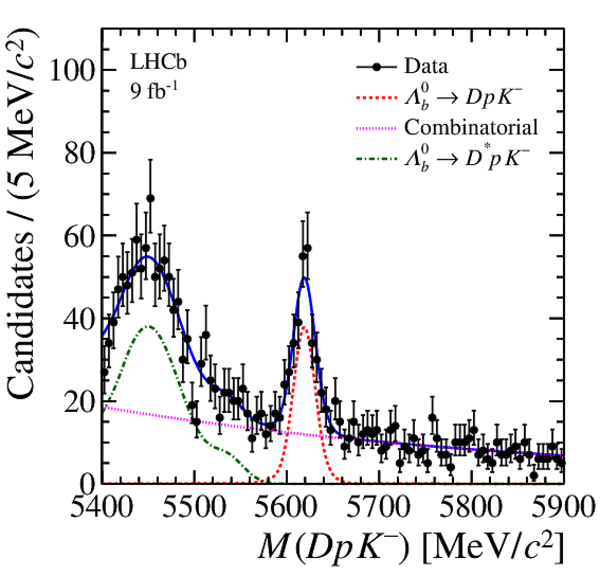
|
|
|
Distributions of the invariant mass for (left) $\Lambda ^0_ b \rightarrow [ K ^- \pi ^+ ]_{D} p K ^- $ and (right) $\Lambda ^0_ b \rightarrow [ K ^+ \pi ^- ]_{D} p K ^- $ candidates, corresponding to the favoured and suppressed decays, respectively, in the restricted phase-space region $M^2(p K ^- )<5 \text{ Ge V} ^2 /c^4 $. The fit, as described in the text, is overlaid. |
Fig2a.pdf [30 KiB] HiDef png [460 KiB] Thumbnail [383 KiB] *.C file |

|
|
Fig2b.pdf [24 KiB] HiDef png [367 KiB] Thumbnail [342 KiB] *.C file |
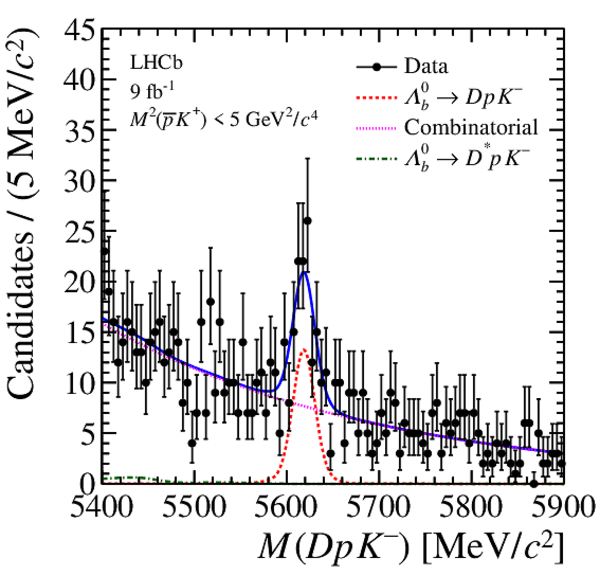
|
|
|
Distributions of the invariant mass for (left) $\Lambda ^0_ b \rightarrow [ K ^+ \pi ^- ]_{D} p K ^- $ and (right) $\overline{ \Lambda} {}^0_ b \rightarrow [ K ^- \pi ^+ ]_{D} \overline p K ^+ $ candidates in the full phase space (black points), corresponding to separation of the suppressed decay sample by $\Lambda ^0_ b $ flavour. The fit, as described in the text, is indicated by the solid blue line, and individual components are indicated. |
Fig3a.pdf [24 KiB] HiDef png [358 KiB] Thumbnail [319 KiB] *.C file |
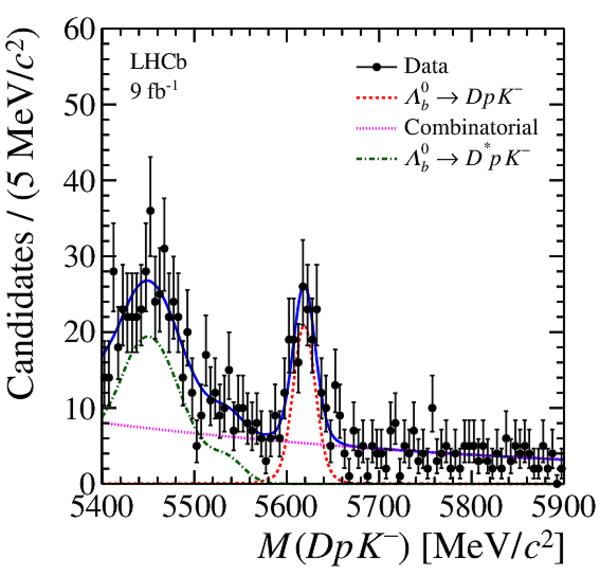
|
|
Fig3b.pdf [24 KiB] HiDef png [354 KiB] Thumbnail [321 KiB] *.C file |
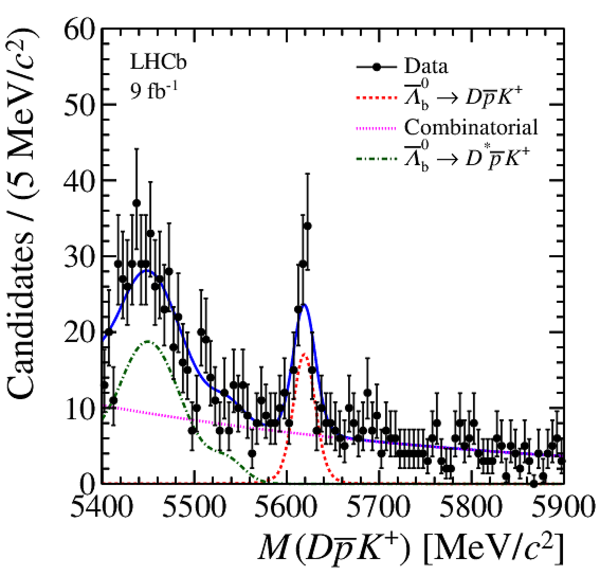
|
|
|
Distributions of the invariant mass for (left) $\Lambda ^0_ b \rightarrow [ K ^+ \pi ^- ]_{D} p K ^- $ and (right) $\overline{ \Lambda} {}^0_ b \rightarrow [ K ^- \pi ^+ ]_{D} \overline p K ^+ $ candidates in the restricted phase-space region (black points), where the separation is made according to the $\Lambda ^0_ b $ flavour. The fit, as described in the text, is indicated by the solid blue line, and individual components are indicated. |
Fig4a.pdf [21 KiB] HiDef png [325 KiB] Thumbnail [293 KiB] *.C file |
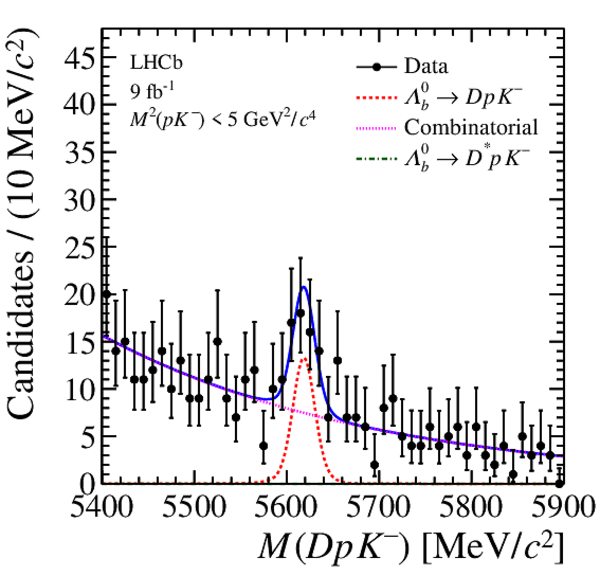
|
|
Fig4b.pdf [22 KiB] HiDef png [339 KiB] Thumbnail [302 KiB] *.C file |
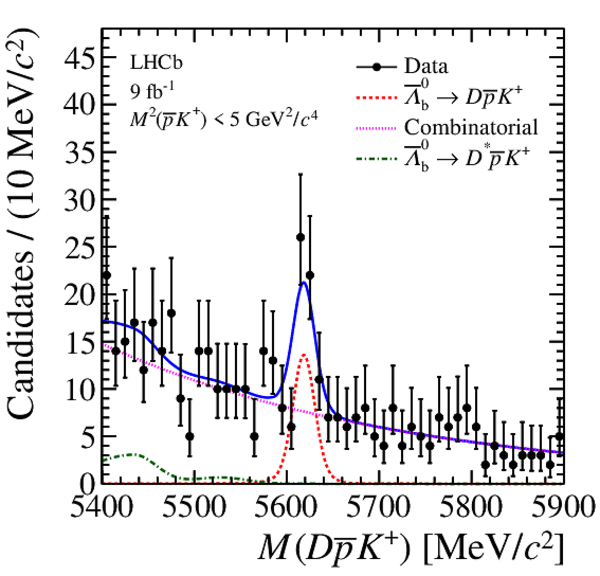
|
|
|
Phase space of the (left) $\Lambda ^0_ b \rightarrow [ K ^- \pi ^+ ]_{D} p K ^- $ and (right) $\Lambda ^0_ b \rightarrow [ K ^+ \pi ^- ]_{D} p K ^- $ candidates having a mass between 5600 and 5640 $\text{ Me V /}c^2$ . No background subtraction is applied. |
Fig5a.pdf [66 KiB] HiDef png [204 KiB] Thumbnail [116 KiB] *.C file |
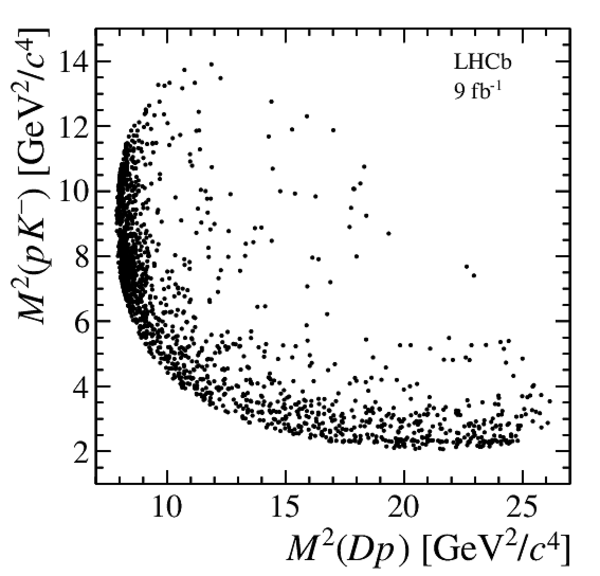
|
|
Fig5b.pdf [24 KiB] HiDef png [133 KiB] Thumbnail [79 KiB] *.C file |
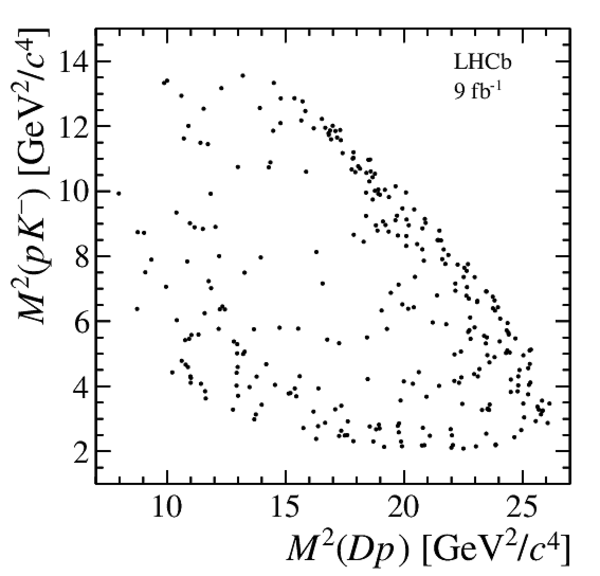
|
|
|
Invariant-mass projections of the $\Lambda ^0_ b $ phase space in (left) $M( D p )$, (middle) $M( p K ^- $), and (right) $M( D K ^- $) for the $\Lambda ^0_ b \rightarrow [ K ^- \pi ^+ ]_{D} p K ^- $ candidates. |
Fig6a.pdf [17 KiB] HiDef png [131 KiB] Thumbnail [80 KiB] *.C file |

|
|
Fig6b.pdf [17 KiB] HiDef png [130 KiB] Thumbnail [76 KiB] *.C file |
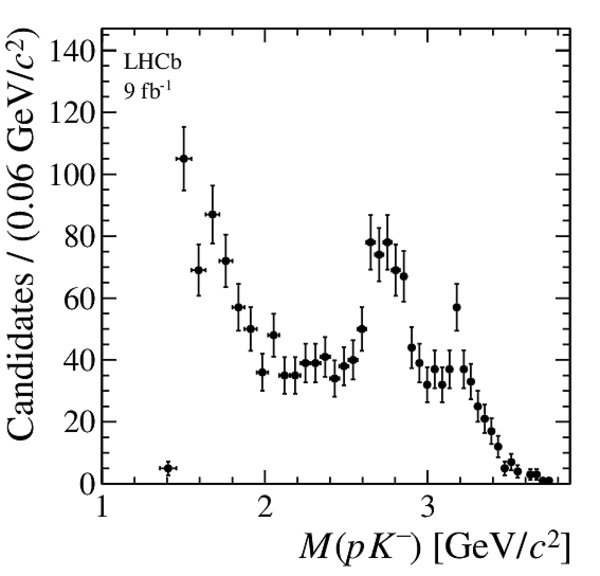
|
|
|
Fig6c.pdf [17 KiB] HiDef png [140 KiB] Thumbnail [84 KiB] *.C file |
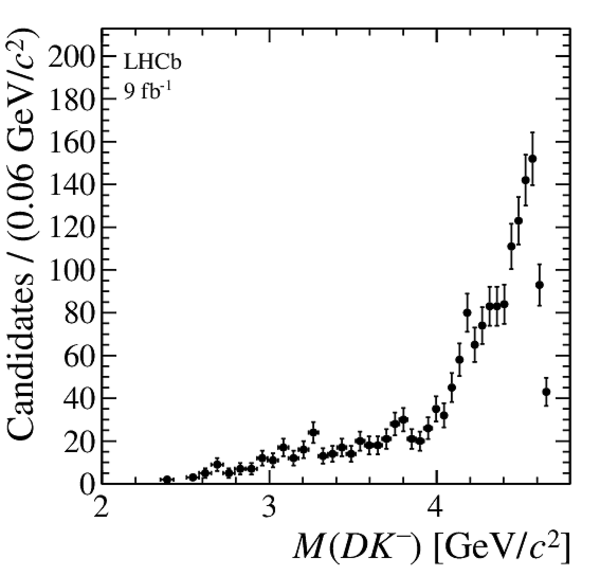
|
|
|
Invariant-mass projections of the $\Lambda ^0_ b $ phase space in (left) $M( D p )$, (middle) $M( p K ^- $), and (right) $M( D K ^- $) for the $\Lambda ^0_ b \rightarrow [ K ^+ \pi ^- ]_{D} p K ^- $ candidates. |
Fig7a.pdf [17 KiB] HiDef png [135 KiB] Thumbnail [78 KiB] *.C file |

|
|
Fig7b.pdf [17 KiB] HiDef png [137 KiB] Thumbnail [80 KiB] *.C file |
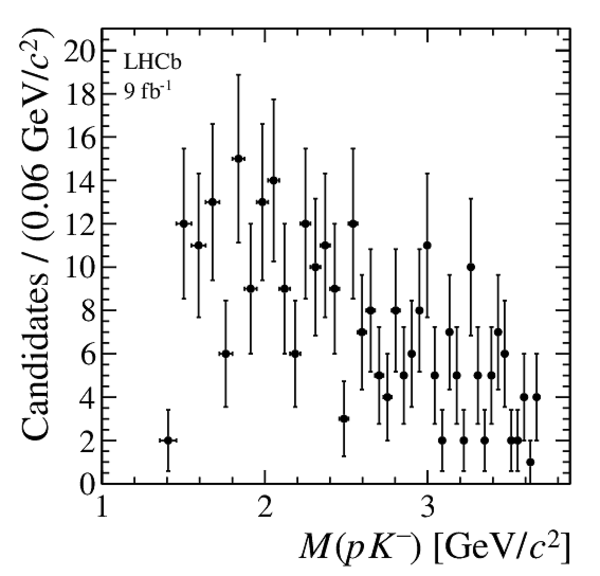
|
|
|
Fig7c.pdf [17 KiB] HiDef png [133 KiB] Thumbnail [83 KiB] *.C file |
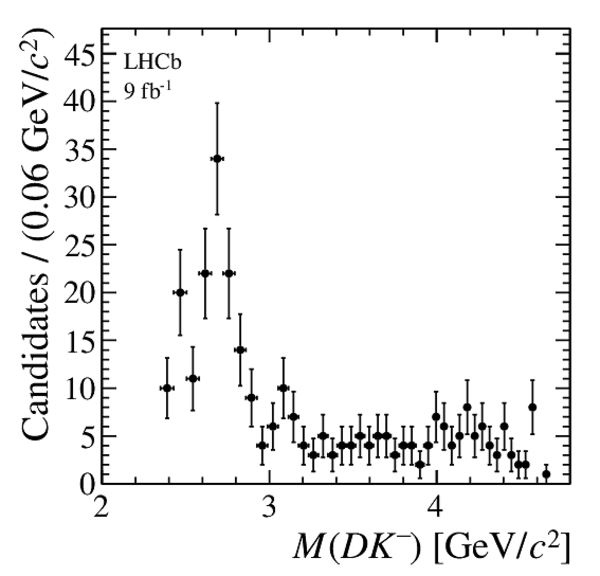
|
|
|
Relative efficiency correction as a function of position within the $\Lambda ^0_ b $ phase space, obtained from simulated samples. |
Fig8.pdf [40 KiB] HiDef png [309 KiB] Thumbnail [495 KiB] *.C file |

|
|
Animated gif made out of all figures. |
PAPER-2021-027.gif Thumbnail |

|
Tables and captions
|
Signal $\Lambda ^0_ b $ yields obtained from fits to the invariant-mass distributions, $M(Dp K ^- )$, for the favoured and suppressed decay samples in the two phase-space regions. |
Table_1.pdf [68 KiB] HiDef png [25 KiB] Thumbnail [12 KiB] tex code |

|
|
Absolute uncertainties on the ratio of branching fractions, $R$, and $ C P$ asymmetry, $A$, related to the sources of systematic uncertainty studied. The statistical and total systematic uncertainties are also shown. |
Table_2.pdf [72 KiB] HiDef png [170 KiB] Thumbnail [77 KiB] tex code |

|
Created on 26 April 2024.
